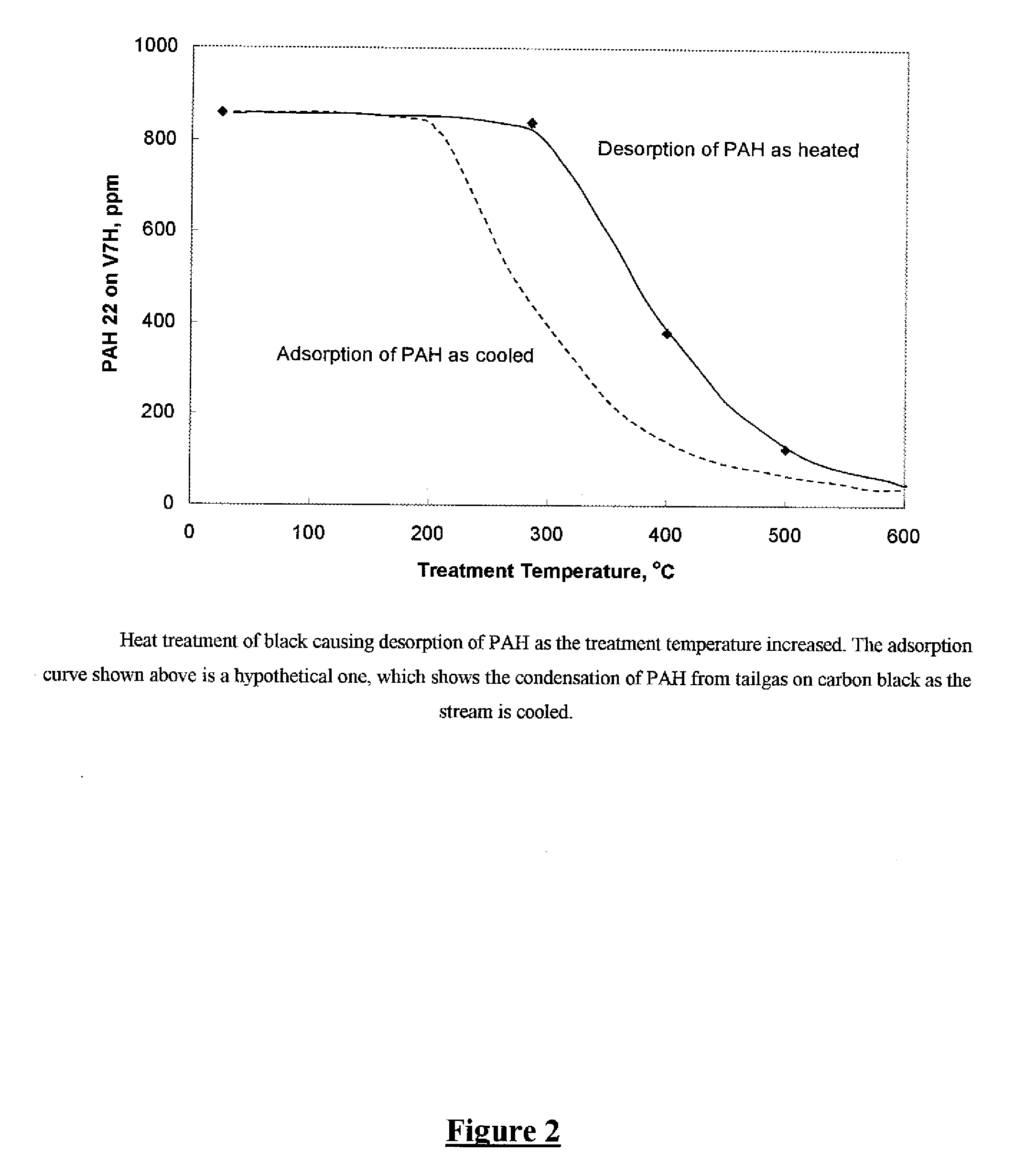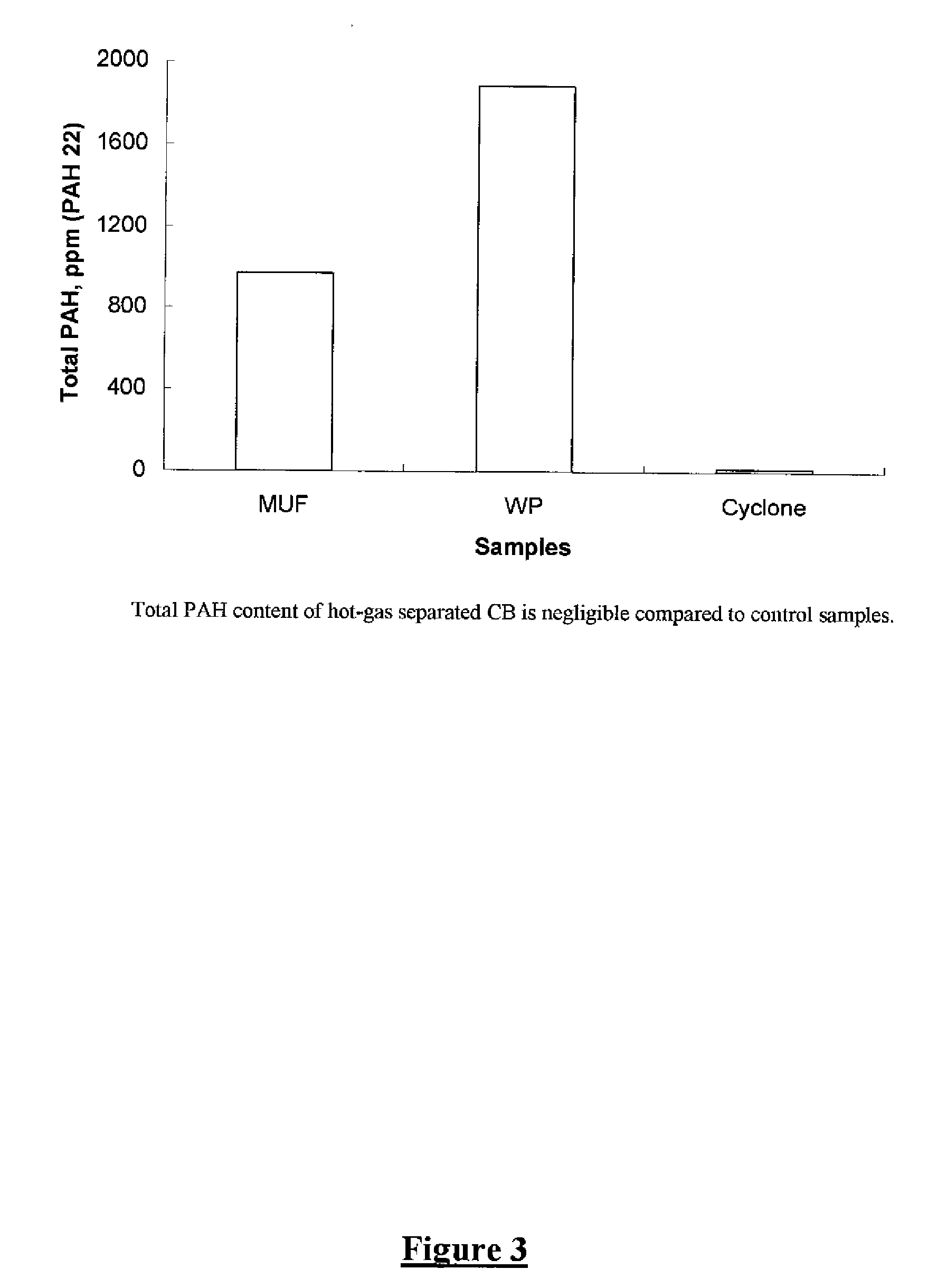Carbon Blacks Having Low PAH Amounts and Methods of Making Same
- Summary
- Abstract
- Description
- Claims
- Application Information
AI Technical Summary
Benefits of technology
Problems solved by technology
Method used
Image
Examples
example 1
[0155]The carbon black samples that are included in the study are the materials manufactured by Cabot Corporation with a furnace process (see, J. B. Donnet, R. C. Bansal, M. J. Wang, “Carbon Black,” SCIENCE AND TECHNOLOGY, 2nd Edition, Marcel Dekker, NY, 1993; and M. J. Wang, C. A. Gray, S. A. Reznek, K. Mahmud, Y. Kutsovsky, “Carbon Black,” in KIRK-OTHMER ENCYCLOPEDIA OF CHEMICAL TECHNOLOGY, John Willey & Sons, 2005, 4, 761). The properties of carbon black are defined by the ASTM (see, ASTM D 1765-03 Standard Classification System for Carbon Blacks Used in Rubber Products) and by the Cabot specifications (see, Web site www.cabot-corp.com).
[0156]The carbon blacks were evaluated in the SBR rubber compound by the ASTM (see, ASTM D 3191-02 Standard Test Methods for Carbon Black in SBR—Recipe and Evaluation Procedures). Typical rubber mixing processes and tests are described in Maurice Morton, RUBBER TECHNOLOGY, 3rd Edition, Van Norstrand Reinhold Company, New York, 1987, and 2nd Editio...
example 2
[0158]In the examples below, two commercially available carbon blacks from Cabot Corporation were tested, namely Vulcan® 7H carbon black and Vulcan® J carbon black. The carbon blacks were subjected to two techniques to remove PAH is, namely extraction by a Soxhlet extraction or the heating of the carbon black. In particular, the extraction and heating tests are set forth below.
[0159]Extraction of 100 gm samples of carbon black was conducted in Soxhlets for 48 hours with 1500 ml of toluene.
[0160]Heating of the carbon black was conducted in an oven with circulation of air or a nitrogen environment. A tray with the size of 1″×12″×12″ was used to spread a 100 gm carbon black sample. Temperature of heating varied between 285 C and 500C. Each heating condition was applied for 1 hour period. Heating temperatures and environments are specified in Table 1 and 2 for each studied sample of carbon black.
[0161]The results of this testing are set forth below. As can be seen, the extraction by use...
example 3
[0162]This experiment was carried out for production of carbon blacks with very low PAH content by hot gas separation. PAH molecules are reformed in the reactor at high temperatures and as the reactor stream is cooled, they condense on the surface of carbon black. The experiment employed a cyclone to separate tail gas from carbon black at a temperature of about 750° C., such that the PAH molecules remained in the gas phase and were not allowed to condense on the carbon black. The carbon black was an STSA equivalent of V7H (112 m2 / g). During the collection of the sample through a cyclone by drawing a side-stream from the reactor, samples from MUF (Main Unit Filter) and pelletizer were also collected as controls. The carbon black collected in the cyclone had a total PAH content of about ˜16 ppm, which turned out to be two orders of magnitude lower than the control samples collected as a part of standard manufacturing procedure. A study of natural rubber compound properties showed that...
PUM
| Property | Measurement | Unit |
|---|---|---|
| Temperature | aaaaa | aaaaa |
| Temperature | aaaaa | aaaaa |
| Temperature | aaaaa | aaaaa |
Abstract
Description
Claims
Application Information
 Login to View More
Login to View More - R&D
- Intellectual Property
- Life Sciences
- Materials
- Tech Scout
- Unparalleled Data Quality
- Higher Quality Content
- 60% Fewer Hallucinations
Browse by: Latest US Patents, China's latest patents, Technical Efficacy Thesaurus, Application Domain, Technology Topic, Popular Technical Reports.
© 2025 PatSnap. All rights reserved.Legal|Privacy policy|Modern Slavery Act Transparency Statement|Sitemap|About US| Contact US: help@patsnap.com



